 Nissan Rogue: Compressed Audio Files (MP3/WMA/AAC/ATRAC3)
Nissan Rogue: Compressed Audio Files (MP3/WMA/AAC/ATRAC3)
Explanation of terms:
- MP3 — MP3 is short for Moving Pictures Experts Group Audio Layer 3. MP3 is the most well known compressed digital audio file format. This format allows for near “CD quality” sound, but at a fraction of the size of normal audio files. MP3 conversion of an audio track can reduce the file size by approximately a 10:1 ratio (Sampling: 44.1 kHz, Bit rate: 128 kbps) with virtually no perceptible loss in quality. The compression reduces certain parts of sound that seem inaudible to most people.
- WMA — Windows Media Audio (WMA) is a compressed audio format created by Microsoft as an alternative to MP3. The WMA codec offers greater file compression than the MP3 codec, enabling storage of more digital audio tracks in the same amount of space when compared to MP3s at the same level of quality.
- AAC/M4A — Advanced Audio Coding (AAC) is a lossy audio compression format.
Audio files that have been encoded with AAC are generally smaller in size and deliver a higher quality of sound than MP3.
- ATRAC3, ATRAC3 Plus - Adaptive Transform Acoustic Coding (ATRAC) is a lossy audio compression format developed by Sony.
- Bit rate — Bit rate denotes the number of bits per second used by a digital music file.
The size and quality of a compressed digital audio file is determined by the bit rate used when encoding the file.
- Sampling frequency — Sampling frequency is the rate at which the samples of a signal are converted from analog to digital (A/D conversion) per second.
- Multisession — Multisession is one of the methods for writing data to media. Writing data once to the media is called a single session, and writing more than once is called a multisession.
- ID3/WMA Tag — The ID3/WMA tag is the part of the encoded MP3 or WMA file that contains information about the digital music file such as song title, artist, album title, encoding bit rate, track time duration, etc.
ID3 tag information is displayed on the Album/Artist/Track title line on the display.
* Windows® and Windows Media® are registered trademarks or trademarks of Microsoft Corporation in the United States of America and/or other countries.
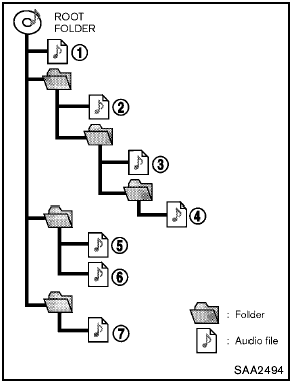
Playback order:
- The folder names of folders not containing compressed audio files are not shown in the display.
- If there is a file in the top level of a disc/USB, “Root Folder” is displayed.
- The playback order is the order in which the files were written by the writing software, so the files might not play in the desired order.
- Music playback order of compressed audio files is as illustrated.
Specification chart (for FM-AM Radio with Compact Disc (CD) player):
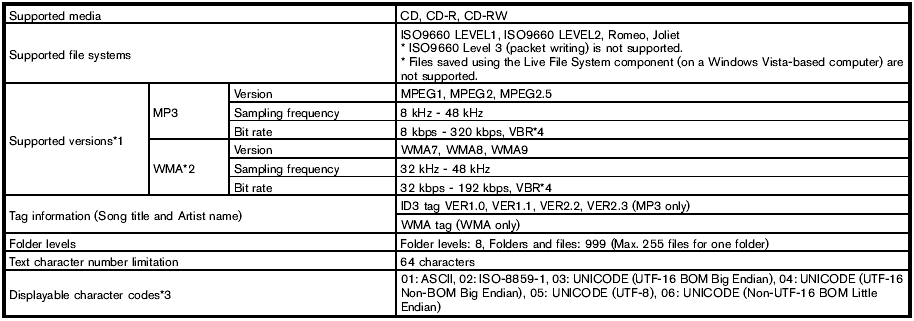
1 Files created with a combination of 48 kHz sampling frequency and 64 kbps bit rate cannot be played.
2 Protected WMA files (DRM) cannot be played.
3 Available codes depend on what kind of media, versions and information are going to be displayed.
4 When VBR files are played, the playback time may not be displayed correctly.
Specification chart (for FM-AM-SAT Radio with Compact Disc (CD) Player (Type A)):
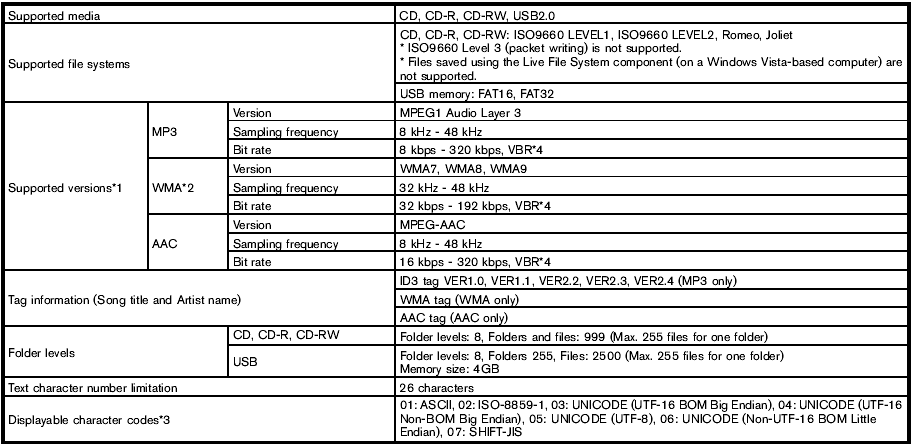
1 Files created with a combination of 48 kHz sampling frequency and 64 kbps bit rate cannot be played.
2 Protected WMA files (DRM) cannot be played.
3 Available codes depend on what kind of media, versions and information are going to be displayed.
4 When VBR files are played, the playback time may not be displayed correctly.
Specification chart (for FM-AM-SAT Radio with Compact Disc (CD) Player (Type B)):

1 Files created with a combination of 48 kHz sampling frequency and 64 kbps bit rate cannot be played.
2 Available codes depend on what kind of media, versions and information are going to be displayed.
Troubleshooting guide (for FM-AM Radio with Compact Disc (CD) player):
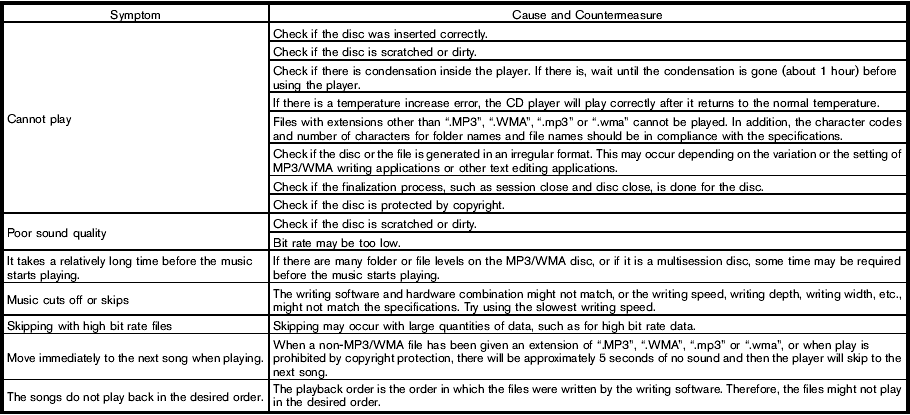
Troubleshooting guide (for FM-AM-SAT Radio with Compact Disc (CD) player (Type A)):
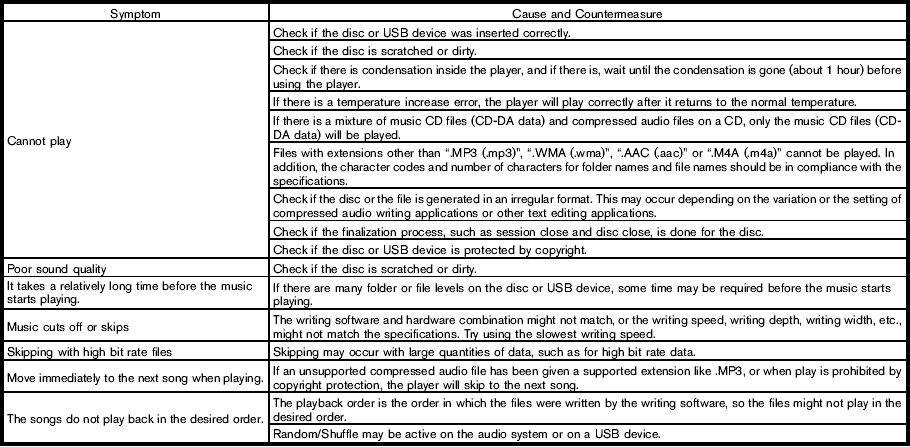
Troubleshooting guide (for FM-AM-SAT Radio with Compact Disc (CD) Player (Type B)):
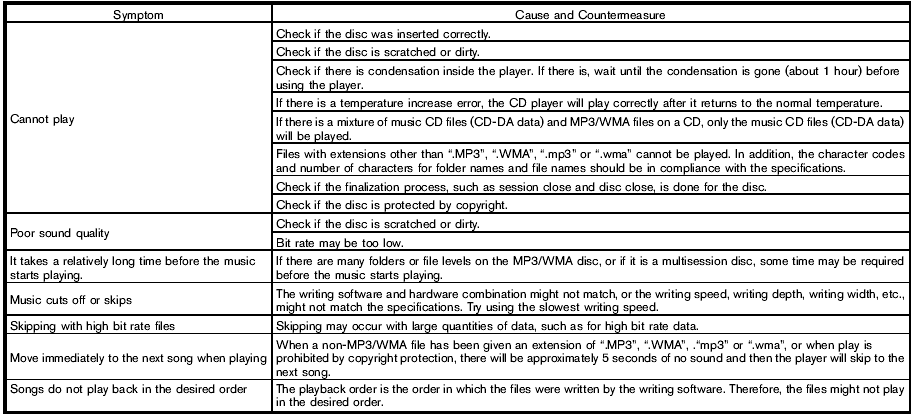
 USB (Universal Serial Bus) devices (if so equipped)
USB (Universal Serial Bus) devices (if so equipped)
This system supports various USB memory
sticks, USB hard drives and iPod® players.
There are some USB devices which may not be
supported with this system.
- Make sure that the USB device is con ...
 FM-AM radio with Compact Disc (CD) player
FM-AM radio with Compact Disc (CD) player
FM-AM radio with Compact Disc (CD) player
1. MUTE button
2. DISP (display)/TEXT button
3. FM·AM radio band select button
4. CD PLAY button
5. Station preset buttons
6. iPod® button
7. ...
See also:
Automatic Temperature Control (ATC) — If Equipped
Automatic Temperature Control ...
Important
WARNING/CAUTION/NOTE Please read this manual and follow its instructions carefully.
To emphasize special information, the symbol
and the words WARNING, CAUTION and
NOTE have special meanings. Pa ...
Cruise control indicator light
This light illuminates when the “CRUISE”
main switch is pressed.
If you press the main switch button while
turning the ignition switch “ON”, the cruise
control function is deactivat ...
